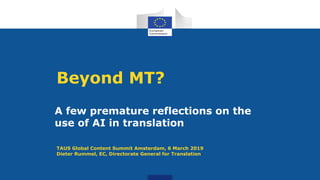
TAUS Global Content Summit Amsterdam 2019 / Beyond MT. A few premature reflections on the use of AI in translation. By Dieter Rummel (Head of Informatics, DGT European Commission)
- 1. Beyond MT? A few premature reflections on the use of AI in translation TAUS Global Content Summit Amsterdam, 6 March 2019 Dieter Rummel, EC, Directorate General for Translation
- 3. Main document types 2015 38 16% 14% 6% 1% 11% 2% 2% 5% 2% 3% 1 EU law, including the legislative process 2 Guardian of the Treaties/Implementation of EU law 3 Correspondence 4 Political documents 5 Relations with other EU institutions 6 Communication, web, media, publications 7 Budget, budgetary procedure 8 Documents linked to international organisations and non-EU countries 9 Notices for publication in OJ 10 Commission working or internal documents 11 Other3
- 4. Evolution 2012-2018 : Number of translated pages and number of DGT staff 2200 2250 2300 2350 2400 2450 2500 2550 2600 0 500,000 1,000,000 1,500,000 2,000,000 2,500,000 2012 2013 2014 2015 2016 2017 2018 Pages Staff
- 5. Context Long-standing use of language technology + CAT tools "More (better) with less" More complexity, new formats, new ways of working Stronger recourse to outsourcing Shift from documents to content Machine Translation as integral part of the resource mix
- 6. EC Systran/ECMT Rule-based MT Ca. 1976 to 2010 MT@EC Statistical MT Moses Decoder 2013 - 2018 eTranslation Neural MT Connecting Europe Facility (CEF) From 2018 Machine translation at DGT
- 7. eTranslation use in DGT (up to Q3/2018)
- 8. Origin of translated segments
- 9. Buzz kill – or why I hate “AI” • Beware of the images • Neural MT vs. Recursive hetero-associative memories for translation • Artificial intelligence is not about intelligence • Neural networks have little to do with actual neurons • Big data + neurons + deep learning + magic = Amazing stuff happens! • Do we really have big(-ish) data? • Believe the hype - but in moderation • Technology is not a solution • Poor processes don’t get better through AI • Doing the same and expecting different results = insanity
- 10. So, this had to be said. But it’s pretty cool anyway. • The technology has become accessible. • “Big data” discussions have shown the possibilities of correlating data from different sources. • New ways of transforming data into usable information? Describe What is happening? Diagnose Why did it happen? Predict What will happen? Decide What should I do?
- 11. Big data? - Big Questions! What we translate • What is the document/content about? • Is the document difficult, i.e. demanding or complex? • Are we working on something similar? • Do we have reliable resources for this document? • How well will MT work for this document? Organising work • How should this content be best translated? • Who is most suitable to translate/revise the document? • How should the content be split between several translators (=meaningful clustering)? • What is our capacity to translate? • Are there meaningful alternatives to the existing forecasting model? External service providers • How good is the contractor’s work? • How confident are we that they will deliver good quality? • How reliable are they? • Can we correlate freelancer/agency, history of evaluations, domain, document type, document complexity to calculate a “reliability indicator” that could support outsourcing decisions?
- 12. More Big Questions! Quality • How good is a given translation? • How good are our language resources? • Can we automatically detect technically and linguistically poor or suspect? • How can we learn from mistakes? Customers • What are the common issues in source documents? • What do they have in common? • Do we have the linguistic resources to handle their documents? • What are their request patterns?
- 13. What next? •Multi-disciplinary •Explore use cases and questions •Break silos •Validate or reject ideas and assumptions in a cost-effective way •Training (also for managers!) •Learn what we do not know •Develop skills •Translation memories •Terminology •XLIFF •“Bad data” •Missing data Think about Data Create understanding and capacity Incubate!Experiment
